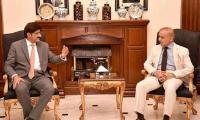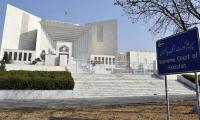Artists are often found exploring dichotomies in the world and their surroundings but it was refreshing to see an exhibition focused on bringing out the opposite forces within us through the use of mirror imagery.
Works part of Karachi-based visual artist Rabia Farooqui’s, ‘Clap Clap, I Approve!’, held at the Sanat Initiative showed different forms of middle-aged men engaged in various activities ranging from exercising to just lazing around.
In every picture, though, the concept of the presence of the other is quite visible. The men who are not fully clothed can be seen in conversation with their other with underlying tones of conflict, harmony and, at times, ambiguity. Confusion can be seen in a picture of three men in baseball helmets running in one direction as two hands clap for them, as if to boost their morale.
In one of the pieces, a man runs on a treadmill while another lies on his back. This, perhaps, portrayed the inner feelings of the man sweating it out on the machine; his inner desire to ditch the workout in favour of some rest and relaxation.
About the symbols used to project conflict, the artist states that she strived to create situations where conflict is always present. “It is a mere contradiction of two opposing thoughts which are influenced by preconceived standards and views set by society.”
A work titled, ‘Ssh, It’s a Pussy Cat’, shows a man pointing at a cat while an arm wearing a coloured cuff is reprimanding him with one finger, explicitly warning him to back away. In the same picture, one hands throws a ball to the cat which is indifferent to their presence.
The figures of men, appearing in all pieces, are symbolic but in some, the man has become a part of the wallpaper as well, perhaps hinting at the dreariness of life as people become part of the places they live by not moving around.
This can also be seen in, ‘A Tournament of Mujras’, as one rests against a wall and the other rests on a chair playing the guitar, with their faces gelling in well with the grey wallpaper.
The usage of patterns owing to walls is also dominant because the design shifts in accordance with the situation created; zigzag is referring to conflict between two or more entities in the piece.
The patterns may also point towards society’s demand to conform and follow a pattern to establish a status-quo. “Thereby, my work takes on a satirical approach to represent an exaggeration of conflict, distraction, opposing views which are inevitably highlighted through the use of these objects and, thus, narratives,” says Rabia, who has majored in Miniature Painting and completed her BFA from Indus Valley School of Art and Architecture.
The exhibit ends on August 3.
The image shows a tobacco company worker holding cigarettes. — AFP/FileHYDERABAD: An illegal cigarette factory...
This image shows the dead body. — AFP/FileAn incident unfolded in Quaidabad on Tuesday, resulting in one fatality...
Edhi Marine Services team is busy in a rescue operation in Karachi on March 17, 2024. — PPI An e-taxi driver...
Shah Abdul Latif University Khairpur building can be seen in this image. — Facebook/Shah Abdul Latif University,...
Representational image of a handcuffed man. — Pexels/FileHYDERABAD: A police operation was carried out in Hyderabad,...
A representational image showing a person handcuffed and standing behind bars. — AFP/FileThe SSGC has continued...







